There’s something so comforting about the aroma of a French stew simmering in the kitchen. These recipes, like Boeuf Bourguignon and Garbure, bring the rustic charm of the French countryside to your table. Each dish is a blend of rich meats, fresh vegetables, and aromatic herbs. Let’s explore these hearty and irresistible stews together. Get ready to uncover the delicious secrets of rural French cooking.
Boeuf Bourguignon
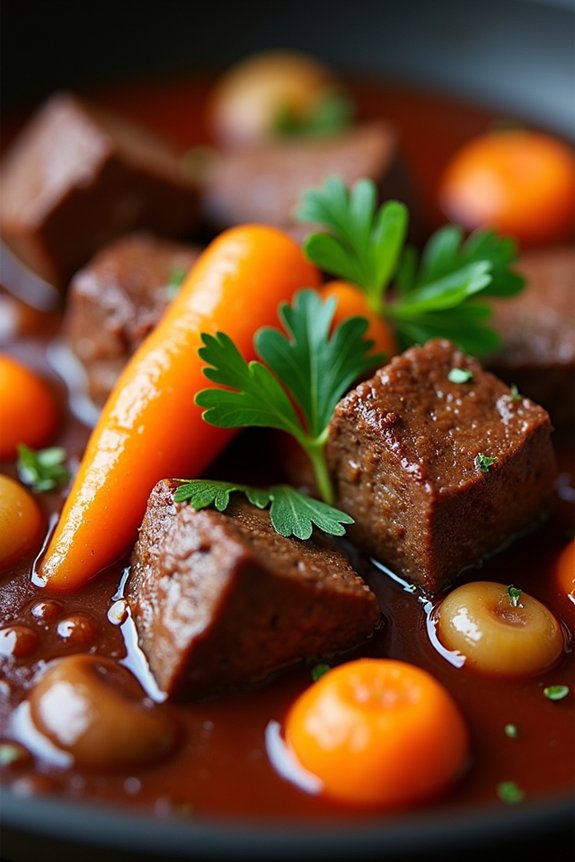
Boeuf Bourguignon is a classic French dish that hails from the Burgundy region. Known for its rich, deep flavors, this stew combines tender beef with a robust red wine sauce, complemented by the earthy flavors of mushrooms, carrots, and onions. Traditionally, this dish is slow-cooked to develop complex layers of taste, making it a perfect comfort meal for chilly days.
The patience required for its preparation pays off as the beef becomes incredibly tender, and the sauce infuses with the aromatic herbs, creating a symphony of flavors that capture the essence of rustic French cuisine.
This iconic stew isn’t just a meal, but an experience that brings a touch of France to your dining table. Whether it’s for a family gathering or a special occasion, Boeuf Bourguignon offers a delightful culinary adventure. To serve 4-6 people, this recipe will guide you through the process of creating an authentic and satisfying dish. Gather the freshest ingredients, and prepare to indulge in a timeless French classic that will surely impress your guests and provide warmth and comfort with every bite.
Ingredients (serving size: 4-6 people):
- 2 pounds beef chuck, cut into 2-inch cubes
- Salt and freshly ground black pepper
- 3 tablespoons olive oil
- 8 ounces bacon, diced
- 1 large onion, chopped
- 2 carrots, sliced
- 3 cloves garlic, minced
- 3 tablespoons all-purpose flour
- 3 cups red wine (preferably Burgundy or Pinot Noir)
- 2 cups beef broth
- 1 tablespoon tomato paste
- 1 bouquet garni (thyme, bay leaf, and parsley tied together)
- 18-24 pearl onions, peeled
- 12 ounces mushrooms, quartered
- 2 tablespoons butter
- Fresh parsley, chopped for garnish
Cooking Instructions:
- Prepare the Beef: Pat the beef cubes dry with paper towels and season generously with salt and pepper. This step guarantees a good sear.
- Sear the Beef: In a large Dutch oven, heat 2 tablespoons of olive oil over medium-high heat. Add the beef cubes in batches to avoid overcrowding. Sear until well-browned on all sides, then remove from the pot and set aside.
- Cook the Bacon: In the same pot, add the diced bacon and cook until crispy. Remove the bacon with a slotted spoon and set aside, leaving the fat in the pot.
- Sauté Aromatics: Add the chopped onion and sliced carrots to the pot. Cook until the onions are soft and translucent, about 5 minutes. Stir in the garlic and cook for an additional minute.
- Thicken with Flour: Sprinkle the flour over the vegetables and stir well to coat. Cook for 2 minutes to remove the raw flour taste.
- Deglaze and Simmer: Slowly pour in the red wine, scraping the bottom of the pot to release any browned bits. Add the beef broth, tomato paste, and bouquet garni. Return the seared beef and bacon to the pot. Bring to a simmer, cover, and let cook on low heat for 2-3 hours, or until the beef is fork-tender.
- Cook Pearl Onions and Mushrooms: In a separate skillet, melt the butter and add the pearl onions. Cook until golden brown, then add the mushrooms. Sauté until mushrooms are browned and tender.
- Combine and Finish: Add the onions and mushrooms to the stew during the final 30 minutes of cooking. Stir well, and adjust seasoning with salt and pepper if needed.
- Garnish and Serve: Remove the bouquet garni before serving. Garnish the stew with freshly chopped parsley and serve with crusty bread or over mashed potatoes.
Extra Tips:
When preparing Boeuf Bourguignon, the quality of the wine is vital as it greatly influences the final flavor of the stew. Opt for a good Burgundy or Pinot Noir that you’d enjoy drinking.
Additionally, allowing the stew to rest for a few hours or overnight can enhance its flavors, as the ingredients have more time to meld together. If you’re short on time, consider using a slow cooker for the simmering process, which can yield equally tender results.
Finally, confirm all ingredients are prepped before you start cooking to streamline the process and maintain the dish’s integrity.
Coq Au Vin
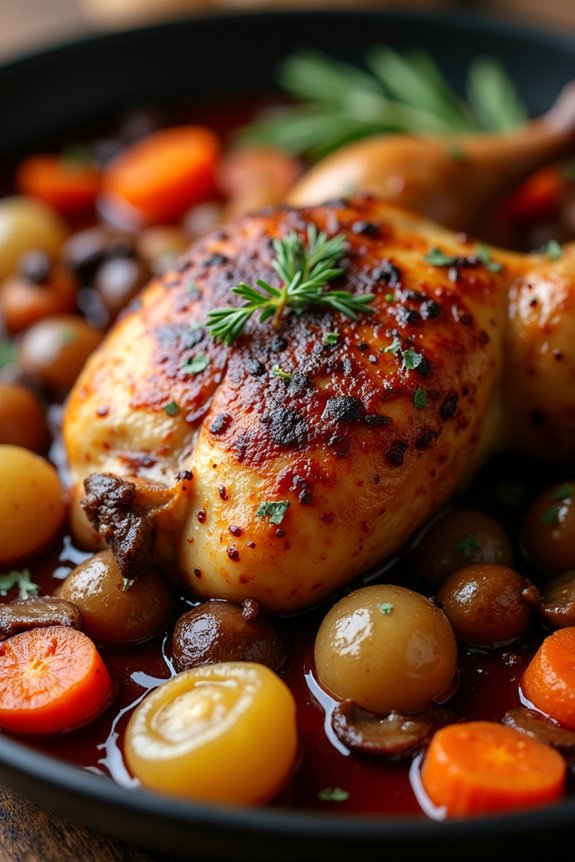
Coq Au Vin is a classic French dish that translates to “rooster in wine.” This rich and hearty stew traditionally uses rooster, but chicken is commonly used in modern recipes due to its availability and tender texture. The dish is simmered slowly in red wine, creating a deep, savory flavor profile that’s both rustic and elegant.
Originating from the Burgundy region, Coq Au Vin showcases the culinary art of transforming simple ingredients into a sumptuous meal, perfect for gatherings or a cozy family dinner.
The key to a successful Coq Au Vin lies in the quality of the red wine and the slow cooking process, which allows the flavors to meld beautifully. A good Burgundy or Pinot Noir is typically recommended, as these wines complement the earthiness of the mushrooms and the sweetness of the pearl onions and carrots.
This dish is often served with crusty bread, mashed potatoes, or noodles to soak up the luscious sauce, ensuring nothing goes to waste.
Ingredients for 4-6 servings:
- 1 whole chicken (about 3-4 pounds), cut into pieces
- Salt and pepper to taste
- 2 tablespoons olive oil
- 4 ounces bacon, diced
- 1/2 cup brandy
- 2 cups Burgundy or Pinot Noir red wine
- 1 cup chicken stock
- 2 tablespoons tomato paste
- 1 bouquet garni (thyme, bay leaf, parsley)
- 2 tablespoons butter
- 2 tablespoons all-purpose flour
- 1/2 pound pearl onions, peeled
- 1/2 pound mushrooms, quartered
- 2 cloves garlic, minced
- 2-3 carrots, sliced
Cooking Instructions:
- Prepare the Chicken: Season the chicken pieces with salt and pepper. In a large Dutch oven or heavy-bottomed pot, heat olive oil over medium-high heat. Brown the chicken pieces on all sides, working in batches if necessary. Remove the chicken and set it aside.
- Cook the Bacon: In the same pot, add the diced bacon and cook until crispy. Remove the bacon and set aside, leaving the rendered fat in the pot.
- Deglaze the Pot: Add the brandy to the pot and carefully ignite it with a long match or lighter. Allow the alcohol to burn off, then return the chicken and bacon to the pot.
- Simmer with Wine and Stock: Pour in the red wine and chicken stock. Stir in the tomato paste and add the bouquet garni. Bring the mixture to a simmer, cover, and cook on low heat for about 1.5 hours, or until the chicken is tender.
- Thicken the Sauce: In a small bowl, combine the butter and flour to form a paste. Gradually whisk the paste into the pot to thicken the sauce, stirring constantly to avoid lumps.
- Cook the Vegetables: In a separate skillet, melt a little butter and sauté the pearl onions, mushrooms, garlic, and carrots until they’re tender and golden. Add the vegetables to the stew, and simmer for another 20-30 minutes.
- Finish and Serve: Remove the bouquet garni. Adjust seasoning with salt and pepper if needed. Serve the Coq Au Vin hot, with your choice of accompaniment like mashed potatoes or crusty bread.
Extra Tips:
For the best results, prepare Coq Au Vin a day ahead and let it rest in the refrigerator overnight. This allows the flavors to deepen and meld together.
When reheating, do so gently over low heat to maintain the integrity of the chicken and the sauce. Additionally, if you find your sauce too thin, reduce it further by simmering uncovered until the desired consistency is achieved. A splash of cognac or brandy before serving can also add a delightful depth to the dish.
Navarin D’agneau
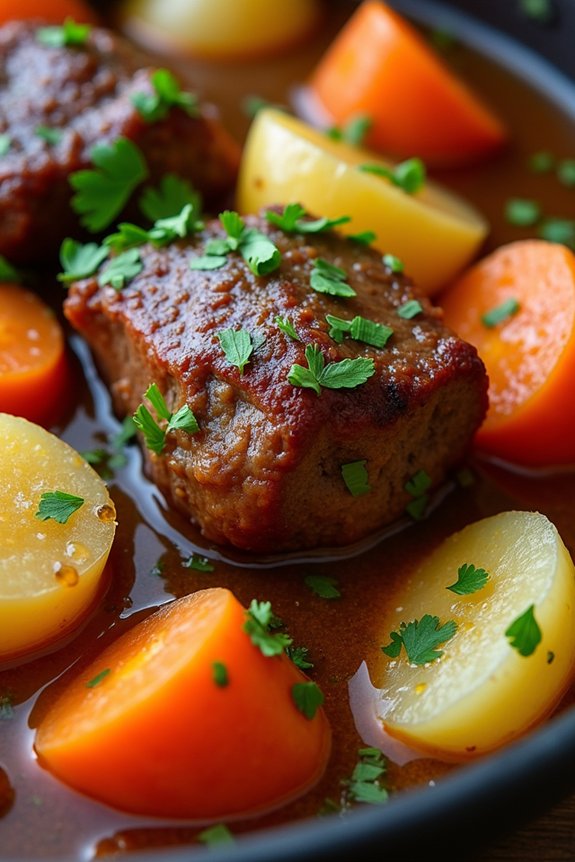
Navarin D’agneau, a classic French country stew, is a delightful way to bring the flavors of the French countryside to your kitchen. This hearty dish features tender lamb simmered to perfection with fresh vegetables, creating a rich and savory meal that’s perfect for gatherings or family dinners. The term “Navarin” refers to the use of lamb (agneau), and it’s traditionally prepared in the spring when the lamb is at its most tender and the vegetables are at their freshest.
A Navarin D’agneau can be a comforting meal that draws on the balance of flavors from the lamb, vegetables, and herbs, making it a dish that warms both the body and the soul.
To start preparing Navarin D’agneau, you’ll need to gather fresh seasonal vegetables like carrots, turnips, and potatoes, as well as a quality cut of lamb shoulder or leg, which is perfect for slow cooking. The recipe also involves an aromatic blend of herbs and a splash of white wine, which helps to deepen the flavors and add complexity to the stew.
While traditionally a spring dish, Navarin D’agneau can be enjoyed any time of year by adjusting the vegetables to suit the season.
Ingredients (Serves 4-6)
- 2 lbs lamb shoulder or leg, cut into 2-inch pieces
- 2 tablespoons olive oil
- 1 large onion, diced
- 3 cloves garlic, minced
- 2 tablespoons tomato paste
- 1 cup dry white wine
- 4 cups beef or chicken stock
- 4 large carrots, peeled and cut into chunks
- 4 small turnips, peeled and quartered
- 1 lb new potatoes, halved
- 1 tablespoon fresh thyme leaves
- 2 bay leaves
- Salt and pepper to taste
- 1 tablespoon chopped fresh parsley (for garnish)
Cooking Instructions
- Brown the Lamb: Heat the olive oil in a large Dutch oven or heavy-bottomed pot over medium-high heat. Add the lamb pieces in batches, searing them on all sides until well-browned. Remove the lamb and set aside.
- Sauté the Aromatics: In the same pot, add the diced onion and garlic. Sauté over medium heat until the onion is translucent and fragrant, about 5 minutes.
- Add Tomato Paste: Stir in the tomato paste and cook for an additional 2 minutes, allowing it to coat the onions and garlic and deepen in flavor.
- Deglaze and Simmer: Pour in the white wine, scraping the bottom of the pot to release any browned bits. Allow the wine to reduce by half, then return the browned lamb to the pot.
- Combine Ingredients: Add the beef or chicken stock, carrots, turnips, potatoes, thyme, and bay leaves. Season with salt and pepper to taste.
- Cook the Stew: Bring the mixture to a boil, then reduce the heat to low. Cover and let it simmer gently for about 1.5 to 2 hours, or until the lamb is tender and the vegetables are cooked through.
- Final Touches: Before serving, check the seasoning and adjust as needed. Remove the bay leaves and garnish with chopped fresh parsley.
Extra Tips
When preparing Navarin D’agneau, allow time for the flavors to meld together; the longer it simmers, the better it tastes. Using a good quality lamb and fresh vegetables will greatly enhance the dish.
If possible, make the stew a day ahead and reheat it gently before serving, as this can enrich the flavors even more. Don’t rush the browning process, as this step is vital for developing the stew’s depth of flavor.
Finally, pair with a crusty French baguette to soak up the savory sauce, completing your French country dining experience.
Cassoulet

- 1 pound dried white beans (such as Great Northern or Cannellini)
- 1 pound pork shoulder, cut into chunks
- 1 pound duck legs or confit
- 1 pound Toulouse sausage or other high-quality pork sausage
- 1/2 pound pancetta or salted pork belly, diced
- 1 large onion, finely chopped
- 4 cloves garlic, minced
- 2 carrots, peeled and chopped
- 2 cups chicken or beef stock
- 1 cup dry white wine
- 2 tablespoons tomato paste
- 2 bay leaves
- 1 teaspoon dried thyme
- Salt and pepper to taste
- 1 cup breadcrumbs
- 2 tablespoons olive oil
- Fresh parsley, chopped for garnish
Cooking Instructions:
- Soak the Beans: Begin by soaking the dried white beans in a large bowl of water overnight or for at least 8 hours. Drain and rinse the beans before using.
- Preheat Oven: Preheat your oven to 300°F (150°C).
- Prepare Meats: In a large ovenproof pot or Dutch oven, heat a tablespoon of olive oil over medium heat. Brown the pork shoulder pieces on all sides, then remove them and set aside. Repeat with the duck legs and sausages, adding more oil if necessary. Remove the meats from the pot once browned.
- Cook Pancetta and Vegetables: Add the pancetta to the pot and cook until it renders its fat and becomes crispy. Add the chopped onion, garlic, and carrots, and sauté until the vegetables are soft and translucent.
- Deglaze and Add Other Ingredients: Stir in the tomato paste, then add the white wine to deglaze the pot, scraping up any browned bits from the bottom. Let the wine reduce slightly before adding the soaked beans, browned meats, bay leaves, thyme, salt, and pepper. Pour in the chicken or beef stock.
- Bake the Cassoulet: Bring the mixture to a simmer on the stovetop, then cover and transfer the pot to the preheated oven. Bake for 2-3 hours, or until the beans are tender and the flavors have melded together.
- Create Breadcrumb Topping: In a small bowl, mix the breadcrumbs with a tablespoon of olive oil. After the cassoulet has cooked, remove the lid and sprinkle the breadcrumb mixture evenly over the top. Increase the oven temperature to 350°F (175°C) and bake for an additional 20-30 minutes, or until the breadcrumbs are golden and crispy.
- Serve: Remove the cassoulet from the oven, garnish with freshly chopped parsley, and serve hot.
Extra Tips:
When preparing Cassoulet, patience is key. The slow cooking process is essential for developing its rich, deep flavors.
If you can’t find Toulouse sausage, a high-quality, mildly seasoned pork sausage will work as a good substitute. For an authentic touch, use duck confit if available, as it adds an extra layer of flavor.
Remember to taste and adjust the seasoning towards the end of cooking, as the flavors will intensify as they meld together. Enjoy this hearty dish with a good glass of wine and crusty bread for a truly comforting meal.
Pot-au-Feu
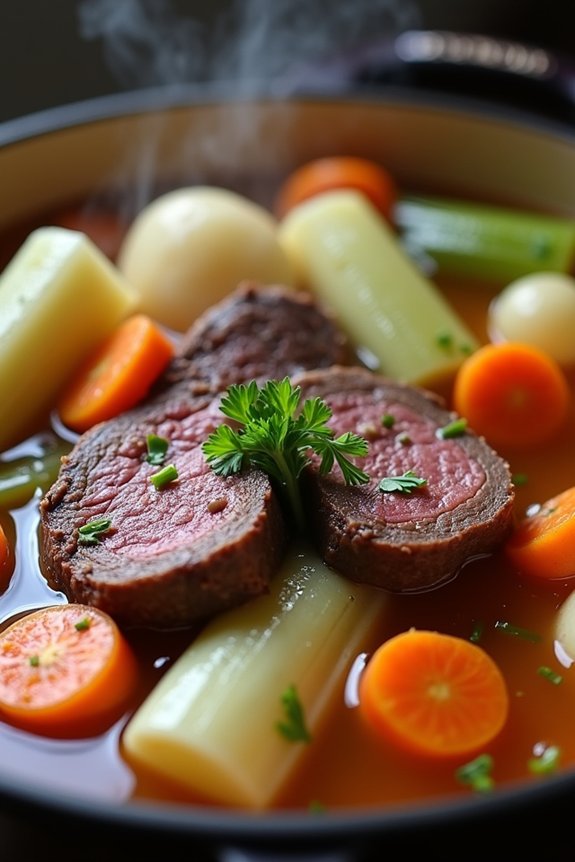
Pot-au-Feu is a classic example of French country cooking, a dish that has stood the test of time due to its simplicity and heartiness. Traditionally, this dish is a rustic and comforting stew made with an assortment of meats and vegetables, simmered together to create a flavorful and hearty meal. The name “Pot-au-Feu” literally translates to “pot on the fire,” reflecting the method of slow-cooking the ingredients in a single pot over a steady flame.
This dish is perfect for family gatherings or Sunday dinners when you want something warm and nourishing. Serving a Pot-au-Feu involves not just the meal itself, but also the experience of gathering around the table with loved ones. The process of preparing the dish is as much about the journey as the delicious outcome.
Historically, Pot-au-Feu was considered a humble meal, using affordable cuts of meat and seasonal vegetables. Today, it retains its wholesome charm, often accompanied by condiments like Dijon mustard, horseradish, or pickles that add a delightful contrast to the rich, meaty broth. The following recipe will serve 4-6 people, making it an ideal choice for a cozy dinner.
Ingredients:
- 2 pounds beef chuck or brisket
- 1 marrow bone
- 4 medium carrots, peeled and halved
- 4 leeks, cleaned and trimmed
- 4 medium potatoes, peeled and halved
- 3 medium onions, peeled
- 4 celery stalks, trimmed
- 1 small cabbage, quartered
- 4 cloves garlic, peeled
- 10 whole black peppercorns
- 2 bay leaves
- Salt to taste
- Fresh parsley for garnish
Instructions:
- Prepare the Meat and Broth:
- Place the beef and marrow bone in a large pot. Cover with cold water and bring to a boil over medium-high heat. Once boiling, reduce to a simmer and skim off any foam that forms on the surface.
- Add Aromatics:
- Add the whole onions, garlic, peppercorns, and bay leaves to the pot. Season with salt. Allow the mixture to simmer gently for about 1.5 hours, confirming the meat becomes tender.
- Cook the Vegetables:
- Add the carrots, leeks, potatoes, celery, and cabbage to the pot. Continue simmering for an additional 30-45 minutes, or until the vegetables are cooked through but not falling apart.
- Adjust Seasoning:
- Taste the broth and adjust seasoning with more salt if necessary. Confirm the flavors are well-balanced and the broth is rich.
- Serve:
- Remove the meat and marrow bone from the pot and slice the beef into thick pieces. Arrange the meat and vegetables on a platter. Strain the broth into a separate serving bowl.
- Garnish and Enjoy:
- Garnish with fresh parsley. Serve the Pot-au-Feu with the broth on the side, along with condiments like Dijon mustard or horseradish.
Extra Tips:
For a richer flavor, you can roast the bones and meat in the oven before adding them to the pot. This step will caramelize the meat and add depth to the broth.
Additionally, consider preparing the Pot-au-Feu a day ahead and refrigerating it overnight. This allows the flavors to meld together beautifully, and any excess fat can be easily removed from the surface before reheating.
Finally, be sure to taste and season as you go to confirm the stew is perfectly balanced to your liking.
Poule Au Pot
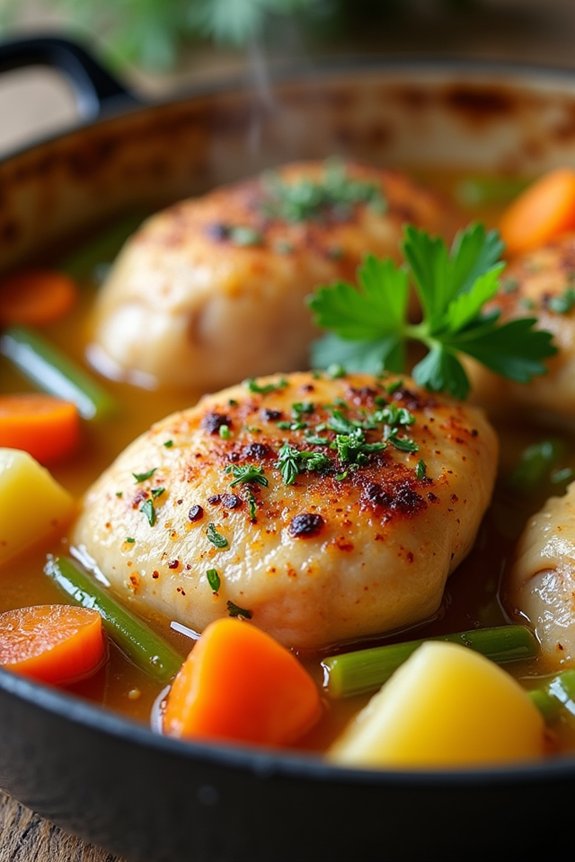
Poule Au Pot, a classic French country stew, is a dish that embodies the essence of rustic French cooking. Traditionally, it was a simple peasant meal, but over time it has become a beloved staple that graces many dinner tables, especially during the colder months. This heartwarming dish typically consists of a whole chicken slowly simmered with a variety of vegetables and herbs, creating a nourishing and flavorful broth.
The beauty of Poule Au Pot lies in its simplicity and the way it brings out the natural flavors of the ingredients. The aroma of Poule Au Pot simmering on the stove fills the kitchen with comforting scents, making it an ideal dish for family gatherings. It’s often served with crusty bread to mop up the delicious broth, guaranteeing that nothing goes to waste.
The vegetables are cooked until tender, and the chicken becomes succulent and infused with the flavors of the herbs and spices. This dish isn’t only a feast for the palate but also a comforting embrace on a chilly day.
Ingredients (Serves 4-6):
- 1 whole chicken (about 3-4 pounds)
- 4 carrots, peeled and cut into large pieces
- 4 leeks, trimmed and cleaned
- 3 onions, peeled and halved
- 3 cloves garlic, peeled
- 3 turnips, peeled and quartered
- 4 potatoes, peeled and quartered
- 1 bouquet garni (parsley, thyme, and bay leaf tied together)
- Salt and pepper to taste
- Water to cover
- Fresh parsley for garnish
Cooking Instructions:
- Prepare the Chicken: Rinse the whole chicken under cold water and pat dry with paper towels. Confirm the cavity is clean and free of any giblets.
- Prepare the Vegetables: Peel and cut the carrots, leeks, onions, garlic, turnips, and potatoes. Make certain the vegetables are cut into large, even pieces for uniform cooking.
- Assemble the Pot: Place the whole chicken in a large pot or Dutch oven. Surround it with the prepared vegetables and add the bouquet garni.
- Season and Add Water: Season with salt and pepper. Pour in enough water to cover the chicken and vegetables completely.
- Simmer: Bring the pot to a gentle simmer over medium heat. Reduce the heat to low, cover the pot, and let it simmer for about 1.5 to 2 hours. The chicken should be cooked through and tender.
- Check for Doneness: Use a meat thermometer to confirm the chicken has reached an internal temperature of 165°F (74°C).
- Serve: Remove the chicken from the pot and carve it into pieces. Serve the chicken with the vegetables and ladle the broth over the top. Garnish with fresh parsley.
Extra Tips:
For a richer flavor, you can brown the chicken in a little olive oil before adding it to the pot. This step is optional but adds a lovely depth to the dish.
Additionally, if you prefer a thicker broth, you can remove some of the cooked vegetables, mash them, and stir them back into the pot. This will thicken the broth naturally. Remember to taste and adjust the seasoning before serving, as the broth can sometimes need a little more salt depending on your preference.
Daube Provençale
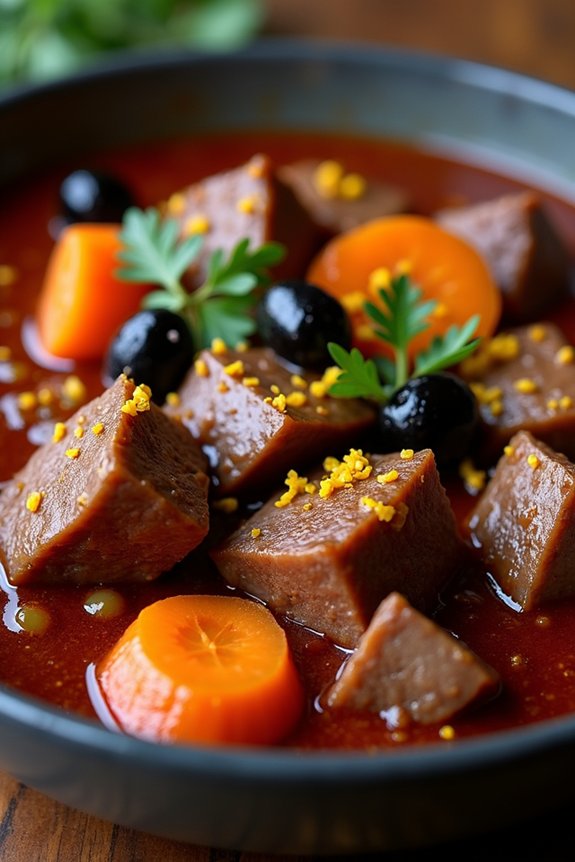
Daube Provençale is a classic French country stew that hails from the Provence region. This dish is known for its rich flavors and tender meat, traditionally made with beef braised in wine, stock, and a medley of aromatic herbs and vegetables. The slow-cooking process allows the flavors to meld beautifully, resulting in a hearty and comforting meal perfect for cooler weather. The use of red wine not only tenderizes the meat but also imparts a deep, robust flavor that’s characteristic of this Provençal specialty.
The origins of Daube Provençale can be traced back to the rural farms of Provence, where it was often prepared in a daubière, a unique type of terracotta pot. While modern versions may not always use this traditional cookware, the essence of the dish remains the same. This recipe combines the time-honored method of slow braising with readily available ingredients, making it accessible for home cooks seeking to bring a taste of France to their kitchens. Serve it with crusty bread or creamy mashed potatoes to soak up the delicious sauce.
Ingredients (Serves 4-6):
- 2 ½ pounds beef chuck, cut into 2-inch cubes
- 1 bottle of full-bodied red wine
- 1 cup beef stock
- 2 onions, chopped
- 4 cloves garlic, minced
- 3 carrots, sliced
- 2 tablespoons tomato paste
- 2 tablespoons olive oil
- 1 tablespoon flour
- 1 bouquet garni (parsley, thyme, bay leaf)
- Salt and pepper to taste
- Zest of 1 orange
- 1 cup black olives, pitted
Cooking Instructions:
- Marinate the Beef: Place the beef cubes in a large bowl. Pour the entire bottle of red wine over the meat, making certain it’s fully submerged. Add the chopped onions, minced garlic, and bouquet garni. Cover and refrigerate for at least 4 hours, preferably overnight, to allow the flavors to infuse.
- Prepare the Oven and Ingredients: Preheat your oven to 325°F (160°C). Remove the beef from the marinade, draining excess liquid, and pat dry with paper towels. Reserve the marinade by straining it into a bowl and set aside the onions and bouquet garni.
- Brown the Meat: In a large Dutch oven or heavy-bottomed pot, heat olive oil over medium-high heat. Add the beef in batches, browning each piece on all sides. Remove browned beef and set aside.
- Sauté Vegetables: In the same pot, add the reserved onions and sauté them until translucent. Stir in the tomato paste and flour, cooking for an additional 2 minutes to eliminate the raw flour taste.
- Deglaze and Combine: Pour the reserved marinade into the pot, scraping up any browned bits from the bottom. Return the beef to the pot, along with the sliced carrots, beef stock, and bouquet garni. Season with salt and pepper.
- Cook the Stew: Bring the mixture to a gentle simmer, then cover and transfer to the preheated oven. Cook for 2 to 3 hours, or until the beef is tender and the sauce has thickened.
- Add Final Touches: About 20 minutes before the stew is done, stir in the orange zest and black olives. Adjust seasoning if necessary.
- Serve: Once cooked, remove the bouquet garni and discard. Serve the Daube Provençale hot, with your choice of side.
Extra Tips:
For a deeper flavor, consider using a wine you enjoy drinking, as its quality will reflect in the final dish. If using a conventional pot instead of a Dutch oven, make certain the lid fits tightly to prevent excessive evaporation.
Additionally, Daube Provençale tastes even better the next day, so feel free to prepare it ahead of time and reheat gently before serving.
Garbure
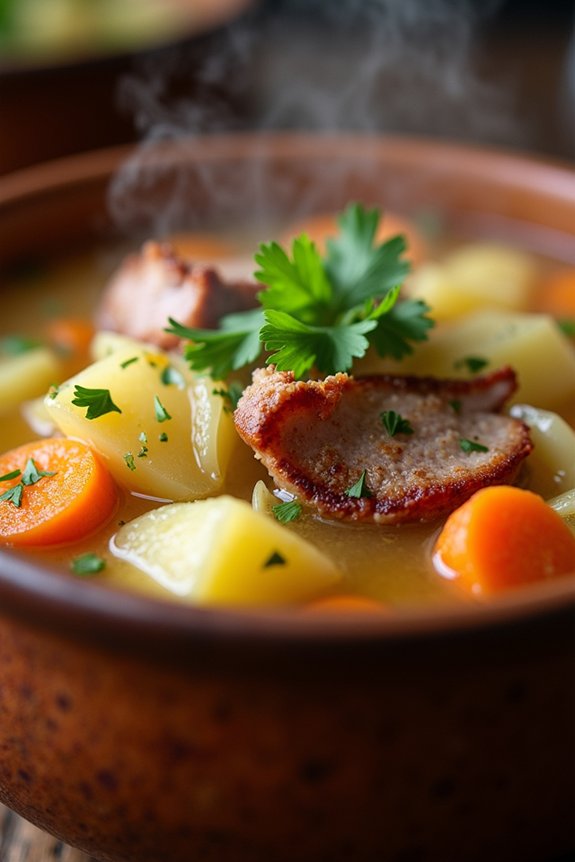
Garbure is a traditional French stew hailing from the Gascony region, known for its rich, hearty texture and robust flavors. This peasant dish was originally designed to make use of whatever vegetables and meats were available, often featuring root vegetables, cabbage, and duck or ham. Over time, it has evolved to include a variety of ingredients that create a comforting, satisfying meal perfect for colder months or any time you crave something warm and nourishing.
The key to a great Garbure is patience and quality ingredients. The stew is slow-cooked to allow the flavors to meld beautifully, resulting in a dish that’s as aromatic as it’s delicious. While the ingredients may vary slightly depending on what’s available, the most common elements include cabbage, potatoes, carrots, and a smoked duck or ham hock for that deep, savory flavor. This recipe will serve 4-6 people, making it an ideal dish for family gatherings or cozy dinner parties.
Ingredients for Garbure (serves 4-6):
- 1 smoked duck leg or ham hock
- 1/2 head of cabbage, chopped
- 2 large carrots, peeled and sliced
- 2 large potatoes, peeled and diced
- 2 leeks, cleaned and sliced
- 2 garlic cloves, minced
- 1 onion, chopped
- 1 bouquet garni (thyme, bay leaf, and parsley tied together)
- 6 cups chicken or vegetable stock
- Salt and pepper to taste
- 1 cup of cooked white beans
- 2 tablespoons of duck fat or olive oil
- 1/4 cup parsley, chopped for garnish
Cooking Instructions:
- Prepare the Meat: In a large pot, heat the duck fat or olive oil over medium heat. Add the smoked duck leg or ham hock and cook until browned on all sides. This step adds depth to the flavor of the stew.
- Build the Base: Add the onion, garlic, leeks, and carrots to the pot. Sauté for about 5 minutes until the vegetables begin to soften. This helps to release their natural sweetness.
- Add Liquids and Seasonings: Pour in the chicken or vegetable stock, and add the bouquet garni. Bring the mixture to a boil, then reduce the heat to low and let it simmer for about 45 minutes, allowing the flavors to meld together.
- Add Vegetables and Beans: Add the cabbage, potatoes, and white beans to the pot. Continue to simmer for another 30 minutes or until the vegetables are tender and the meat is falling off the bone.
- Season and Serve: Remove the bouquet garni and discard. Taste the stew and season with salt and pepper as needed. Remove the duck leg or ham hock, shred the meat, and return it to the pot. Serve hot, garnished with chopped parsley.
Extra Tips:
For an even richer flavor, prepare the Garbure a day in advance and reheat it before serving. This allows the flavors to develop further.
If you prefer a thicker stew, mash some of the potatoes and beans before adding them back to the pot. You can also add a splash of white wine with the stock for an additional layer of flavor.
Blanquette De Veau
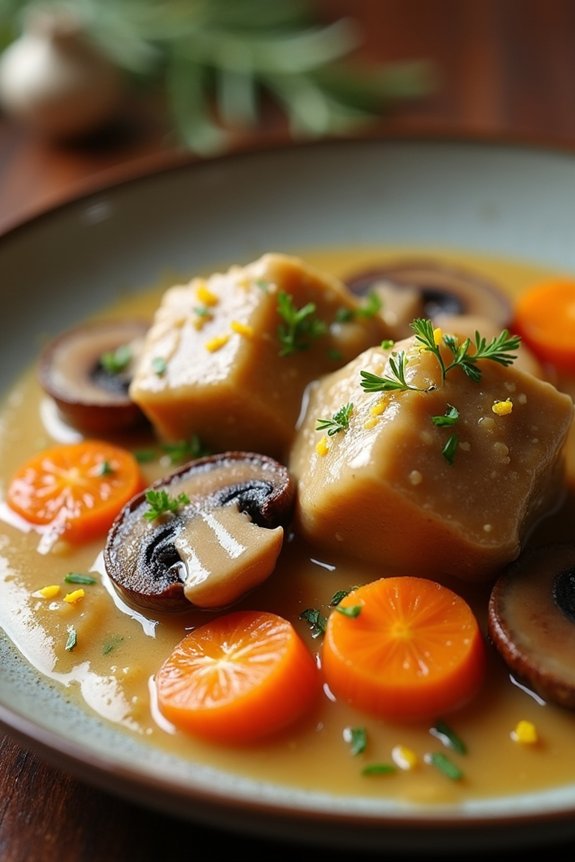
Blanquette De Veau is a classic French country stew that captures the essence of rustic, comforting cuisine. This delightful dish centers around tender veal simmered slowly in a creamy white sauce, elevated with aromatic vegetables and herbs. Its roots trace back to French culinary traditions where simplicity meets elegance, making it a beloved staple in many households.
This dish is perfect for a cozy family dinner or an impressive main course when entertaining guests, offering a taste of the French countryside with every bite.
The key to an authentic Blanquette De Veau lies in the careful preparation of the ingredients and the slow cooking process that allows the flavors to meld beautifully. The result is a rich, velvety sauce that coats the tender pieces of veal, complemented by the subtle sweetness of carrots and the earthy undertones of mushrooms.
Serve it alongside a bed of rice or buttered noodles to soak up the delicious sauce, and enjoy the symphony of flavors that this traditional stew has to offer. Here’s how you can prepare this dish for 4-6 people.
Ingredients:
- 2 pounds veal shoulder, cut into 1.5-inch cubes
- 2 tablespoons olive oil
- 1 tablespoon unsalted butter
- 1 large onion, peeled and quartered
- 2 carrots, peeled and sliced
- 2 cloves of garlic, crushed
- 1 bouquet garni (parsley, thyme, and bay leaf tied together)
- 1 teaspoon salt
- ½ teaspoon freshly ground black pepper
- 2 cups chicken or veal stock
- 1 cup dry white wine
- 1 cup heavy cream
- 1 tablespoon lemon juice
- 1 cup button mushrooms, cleaned and halved
- 2 egg yolks
- 1 tablespoon all-purpose flour
Instructions:
- Prepare the Veal: Begin by patting the veal cubes dry with paper towels. This helps to guarantee proper browning. Season lightly with salt and pepper.
- Brown the Meat: In a large heavy-bottomed pot, heat the olive oil and butter over medium-high heat. Add the veal cubes in batches, browning them on all sides. Remove the browned veal and set it aside.
- Sauté the Vegetables: In the same pot, reduce the heat to medium and add the onion, carrots, and garlic. Sauté until the onions are translucent and fragrant, about 5 minutes.
- Deglaze the Pot: Pour in the white wine to deglaze the pot, scraping up any browned bits from the bottom. Let the wine reduce slightly for about 2 minutes.
- Simmer the Stew: Return the veal to the pot and add the bouquet garni, chicken or veal stock, salt, and pepper. Bring the mixture to a simmer, then reduce the heat to low. Cover and let it cook gently for about 1.5 to 2 hours, or until the veal is tender.
- Prepare the Mushrooms: Meanwhile, in a separate pan, sauté the mushrooms in a bit of butter until they’re golden brown and set aside.
- Thicken the Sauce: In a small bowl, whisk together the egg yolks, flour, and heavy cream. Gradually stir this mixture into the pot, ensuring it’s well combined. Add the mushrooms and lemon juice, and continue to cook over low heat for an additional 10 minutes, allowing the sauce to thicken. Adjust seasoning with salt and pepper to taste.
- Serve: Remove the bouquet garni before serving. Serve the Blanquette De Veau hot over rice or buttered noodles, garnished with fresh parsley if desired.
Extra Tips:
For the best flavor, consider marinating the veal in the white wine and herbs overnight. This step is optional but can enhance the dish’s depth.
When thickening the sauce with the egg yolk and cream mixture, guarantee the stew isn’t boiling to prevent the eggs from curdling. If you prefer a thicker sauce, you can increase the amount of flour slightly.
Use high-quality veal and fresh herbs for the most authentic taste. Enjoy your Blanquette De Veau with a glass of the same dry white wine used in the recipe for a complete culinary experience.
Soupe Au Pistou
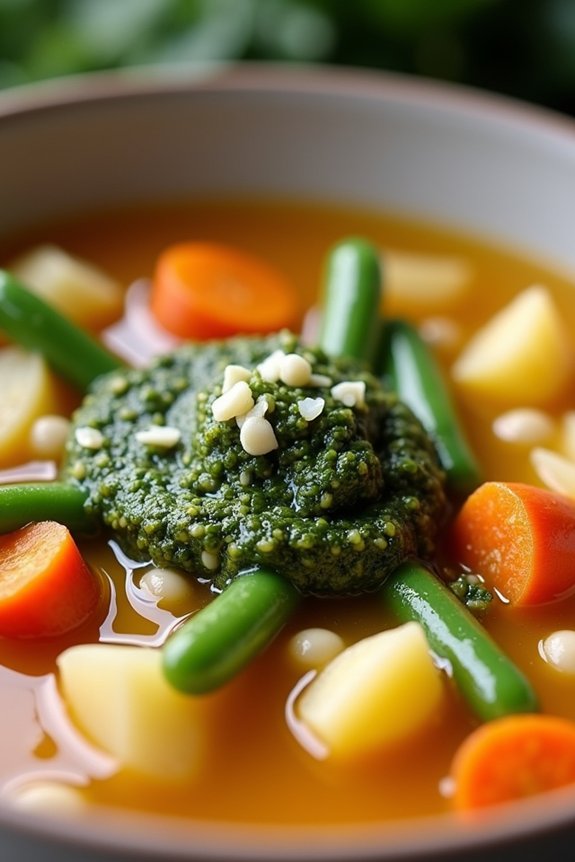
Soupe Au Pistou is a classic Provençal dish that embodies the essence of French country cooking. This fragrant vegetable soup is enriched with a vibrant pistou — the French cousin of Italian pesto — made from fresh basil, garlic, and olive oil.
Soupe Au Pistou is a celebration of fresh, seasonal ingredients, making it a perfect dish for late summer when vegetables are at their peak. This hearty stew is typically served with a dollop of pistou on top, which melts into the hot broth, releasing its aromatic flavors.
The beauty of Soupe Au Pistou lies in its simplicity and versatility. Traditionally, it includes a variety of vegetables such as green beans, potatoes, and tomatoes, alongside tender white beans and small pasta. Each ingredient is cooked to perfection, contributing to a delightful balance of textures and flavors.
This recipe is designed for 4-6 servings, making it an excellent choice for a family meal or a gathering with friends. The preparation is straightforward, ensuring that even novice cooks can create this delicious and comforting dish.
Ingredients:
- 2 tablespoons olive oil
- 1 large onion, chopped
- 3 cloves garlic, minced
- 2 carrots, diced
- 2 zucchinis, diced
- 1 cup green beans, trimmed and cut into 1-inch pieces
- 2 medium potatoes, peeled and diced
- 4 tomatoes, peeled, seeded, and chopped
- 1 can (15 oz) white beans, drained and rinsed
- 6 cups vegetable or chicken stock
- 1/2 cup small pasta (such as ditalini or macaroni)
- Salt and pepper to taste
For the Pistou:
- 2 cups fresh basil leaves
- 2 cloves garlic, minced
- 1/2 cup grated Parmesan cheese
- 1/2 cup olive oil
- Salt and pepper to taste
Cooking Instructions:
- Prepare the Soup Base:
- In a large pot, heat 2 tablespoons of olive oil over medium heat. Add the chopped onion and minced garlic, sautéing until the onion becomes translucent, about 5 minutes.
- Add Vegetables:
- Stir in the diced carrots, zucchinis, green beans, and potatoes. Cook for an additional 5 minutes, stirring occasionally to combine the flavors.
- Simmer the Soup:
- Add the chopped tomatoes, white beans, and vegetable or chicken stock to the pot. Bring the mixture to a boil, then reduce the heat to low. Cover the pot and let the soup simmer for 30 minutes, or until the vegetables are tender.
- Cook the Pasta:
- Stir in the small pasta and let the soup continue to simmer for another 10 minutes, or until the pasta is al dente.
- Prepare the Pistou:
- While the soup is simmering, prepare the pistou by combining the basil leaves, minced garlic, Parmesan cheese, and olive oil in a food processor. Blend until smooth, seasoning with salt and pepper to taste.
- Serve:
- Ladle the hot soup into bowls and add a generous spoonful of pistou on top of each serving. Stir the pistou into the soup just before eating to release its full flavor.
Extra Tips:
For the best Soupe Au Pistou, use the freshest herbs and vegetables available, as their flavors will truly shine in this dish.
If you prefer a more robust broth, consider using chicken stock instead of vegetable stock. To save time, canned diced tomatoes can replace fresh tomatoes, though fresh will provide a more authentic taste.
Adjust the seasoning according to your preference, and feel free to experiment with different types of beans or pasta to suit your taste.
Lapin À La Moutarde

Lapin À La Moutarde, or Rabbit with Mustard Sauce, is a classic French country stew that embodies the rustic charm and hearty flavors of traditional French cuisine. This delightful dish combines tender rabbit meat with a creamy, tangy mustard sauce, creating a meal that’s both comforting and sophisticated.
The combination of Dijon mustard and fresh herbs infuses the rabbit with a deep, savory flavor that’s perfectly balanced by the richness of the sauce. Whether you’re looking to impress dinner guests or simply enjoy a taste of French country cooking, Lapin À La Moutarde is sure to please.
This recipe serves 4-6 people and offers a wonderful way to introduce rabbit into your culinary repertoire. The preparation is straightforward, making it an excellent choice for both experienced cooks and those new to cooking with rabbit. By following these steps, you’ll be able to create a dish that’s not only delicious but also a beautiful centerpiece for your dining table.
Ingredients:
- 1 whole rabbit (about 3 to 4 lbs), cut into pieces
- Salt and freshly ground black pepper
- 2 tablespoons olive oil
- 1 onion, finely chopped
- 2 cloves garlic, minced
- 1/2 cup Dijon mustard
- 1/2 cup dry white wine
- 1 cup chicken stock
- 1 tablespoon fresh thyme leaves
- 2 bay leaves
- 1/2 cup heavy cream
- 2 tablespoons chopped fresh parsley
- 2 tablespoons unsalted butter
Instructions:
- Prepare the Rabbit: Season the rabbit pieces with salt and pepper. Set aside while you prepare the other ingredients.
- Brown the Rabbit: Heat the olive oil in a large, heavy-bottomed pot or Dutch oven over medium heat. Add the rabbit pieces in batches, and cook until browned on all sides. Remove the browned rabbit pieces from the pot and set them aside.
- Sauté the Aromatics: In the same pot, add the chopped onion and minced garlic. Sauté for about 5 minutes, or until the onion is translucent and fragrant.
- Add Mustard and Wine: Stir in the Dijon mustard, ensuring the onion and garlic are well coated. Pour in the white wine, scraping the bottom of the pot to release any browned bits, and bring to a simmer.
- Simmer with Stock and Herbs: Return the rabbit pieces to the pot. Add the chicken stock, thyme, and bay leaves. Bring the mixture to a gentle simmer, cover the pot, and cook for about 1 hour, or until the rabbit is tender and cooked through.
- Finish the Sauce: Remove the rabbit pieces and bay leaves from the pot. Stir in the heavy cream and butter, and let the sauce simmer uncovered for about 10 minutes, or until it thickens slightly. Season with additional salt and pepper to taste.
- Serve: Return the rabbit to the pot to warm through. Sprinkle with chopped parsley before serving.
Extra Tips:
When cooking Lapin À La Moutarde, it’s crucial to monitor the heat closely to prevent the mustard and cream sauce from curdling. If you find the sauce becoming too thick, feel free to add a little more chicken stock or water to achieve your desired consistency.
Additionally, if rabbit isn’t readily available, you can substitute chicken thighs, which will also absorb the rich flavors beautifully. Serve this dish with crusty bread or buttered noodles to soak up the delicious sauce.
Bouillabaisse
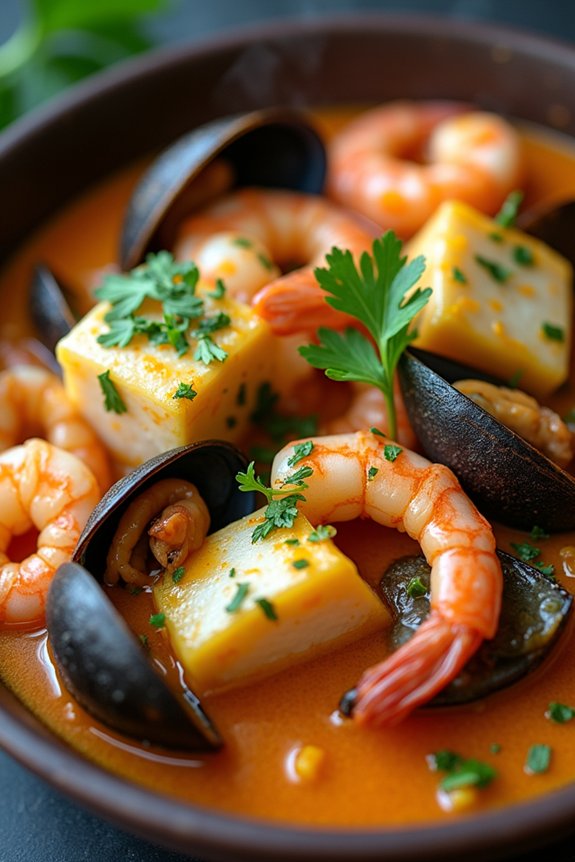
Bouillabaisse is a classic French fish stew that hails from the sunny shores of Provence. Originally created by fishermen who used the bony rockfish they couldn’t sell to make this hearty dish, it has since become a gourmet staple in French cuisine.
This aromatic stew is made with a variety of fresh fish and shellfish, simmered in a rich broth infused with saffron, fennel, and orange zest. The dish is traditionally served with a side of rouille sauce, a spicy mayonnaise that complements the complex flavors of the stew perfectly.
The magic of bouillabaisse lies in its rich broth, which is both fragrant and flavorful, thanks to a blend of Provençal herbs and spices. The key to a perfect bouillabaisse is using the freshest seafood available, guaranteeing that each bite is a taste of the sea.
This recipe will guide you through the process of creating an authentic bouillabaisse for 4-6 people, perfect for a cozy gathering or special occasion meal.
Ingredients for 4-6 servings:
- 1 large onion, chopped
- 2 leeks, white and light green parts, sliced
- 1 bulb of fennel, sliced
- 3 cloves garlic, minced
- 2 tablespoons olive oil
- 1 teaspoon saffron threads
- 1/2 teaspoon dried thyme
- 1 bay leaf
- Zest of 1 orange
- 2 cups fish stock
- 1 cup white wine
- 2 cups water
- 1 pound firm white fish (such as cod or haddock), cut into chunks
- 1/2 pound mussels, cleaned and debearded
- 1/2 pound clams, scrubbed
- 1/2 pound shrimp, peeled and deveined
- Salt and pepper to taste
- Fresh parsley, chopped for garnish
- Lemon wedges for serving
Cooking Instructions:
- Prepare the Aromatics: In a large pot, heat olive oil over medium heat. Add the chopped onion, leeks, fennel, and garlic. Sauté until the vegetables are softened and translucent, about 5-7 minutes.
- Infuse the Broth: Stir in the saffron threads, thyme, bay leaf, and orange zest. Cook for an additional 2 minutes to allow the spices to release their aromas.
- Build the Base: Pour in the fish stock, white wine, and water. Bring the mixture to a gentle simmer and let it cook for about 20 minutes to enhance the flavors.
- Cook the Seafood: Add the white fish chunks to the pot. Cover and simmer for 5 minutes, then add the mussels, clams, and shrimp. Cook until the shellfish open and the shrimp turn pink, about 5-7 minutes. Discard any mussels or clams that don’t open.
- Season and Serve: Taste the broth and adjust seasoning with salt and pepper. Remove the bay leaf and sprinkle fresh parsley over the stew. Serve hot with lemon wedges on the side for added brightness.
Extra Tips:
For the best bouillabaisse, use a variety of fish to add depth of flavor to the broth. If you can’t find all the seafood varieties, feel free to substitute with what’s available, but ascertain it’s fresh.
To make the dish truly authentic, consider serving with a side of toasted baguette slices and rouille sauce for dipping. Finally, be careful not to overcook the seafood; it should be tender and just cooked through to maintain its delicate texture.
Marmite Dieppoise
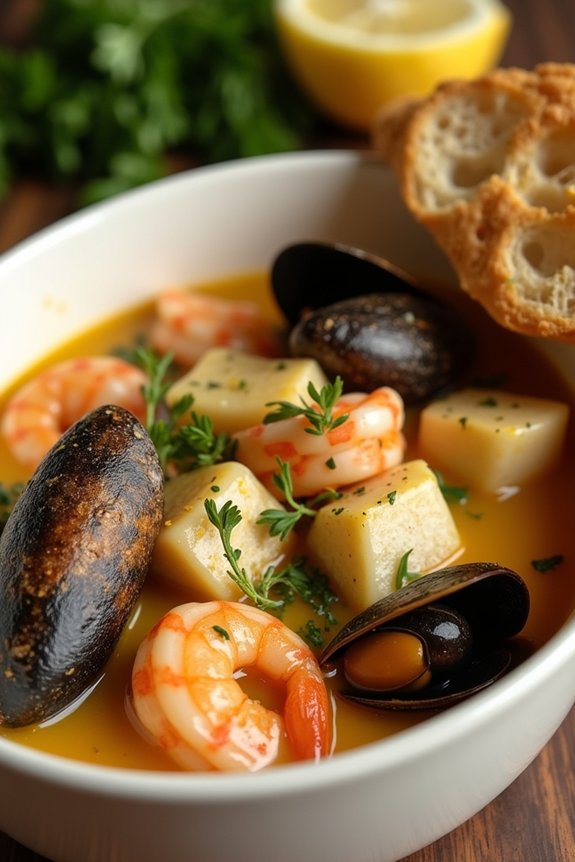
Marmite Dieppoise is a traditional French seafood stew originating from the Normandy region, specifically the port town of Dieppe. Known for its rich and creamy texture, this dish combines the fresh flavors of the sea with the earthy tones of mushrooms, making it a hearty yet elegant option for a family meal or a sophisticated dinner party.
The stew is often served with crusty bread to soak up the flavorful broth, and it’s a perfect representation of French coastal cuisine.
This stew features a variety of seafood such as white fish, mussels, and shrimp, simmered in a luscious cream sauce with a hint of vermouth or white wine. The addition of vegetables like leeks and mushrooms adds depth to the dish, while the infusion of herbs like thyme and parsley enhances its aromatic profile.
Marmite Dieppoise is a dish that showcases the simplicity and elegance of French country cooking, making it a must-try for those who appreciate gourmet seafood dishes.
Ingredients (serving size: 4-6 people):
- 1 pound white fish fillets (such as cod or haddock)
- 1/2 pound mussels, cleaned and debearded
- 1/2 pound shrimp, peeled and deveined
- 2 tablespoons butter
- 1 tablespoon olive oil
- 2 leeks, white parts only, sliced
- 8 ounces mushrooms, sliced
- 2 garlic cloves, minced
- 1 cup dry white wine or vermouth
- 1 cup fish or seafood stock
- 1 cup heavy cream
- 1 teaspoon fresh thyme leaves
- Salt and pepper to taste
- 2 tablespoons fresh parsley, chopped
- Lemon wedges, for serving
Cooking Instructions:
- Prepare the Seafood: Begin by rinsing the white fish fillets under cold water and pat them dry with paper towels. Cut the fillets into 2-inch pieces and set aside. Verify the mussels are cleaned and debearded, and the shrimp are peeled and deveined.
- Sauté the Vegetables: In a large pot or Dutch oven, heat the butter and olive oil over medium heat. Add the sliced leeks and mushrooms, and sauté until the leeks are soft and the mushrooms are golden brown, about 5-7 minutes. Add the minced garlic and sauté for an additional 1 minute until fragrant.
- Deglaze the Pan: Pour the white wine or vermouth into the pot, gently scraping the bottom to release any browned bits. Allow the liquid to simmer and reduce by half, about 3-5 minutes.
- Add Stock and Seafood: Stir in the fish or seafood stock, then add the white fish pieces, mussels, and shrimp into the pot. Season with salt, pepper, and thyme leaves. Cover the pot and let it simmer for 5-7 minutes, until the mussels have opened and the shrimp are pink and cooked through.
- Finish with Cream: Reduce the heat to low and stir in the heavy cream. Allow the stew to gently heat through without boiling, which should take another 3-5 minutes. Taste and adjust the seasoning if necessary.
- Serve: Ladle the stew into bowls and garnish with chopped parsley. Serve hot with lemon wedges on the side and crusty bread to accompany the dish.
Extra Tips: To verify that the mussels are safe to eat, discard any that don’t open after cooking. When selecting the seafood, fresh is always best, but you can also use high-quality frozen seafood if necessary.
Feel free to experiment with different types of fish and shellfish based on availability and preference. For a slightly thicker broth, you can add a tablespoon of flour to the sautéed vegetables before deglazing the pan. Enjoy Marmite Dieppoise with a glass of the same white wine used in the recipe for a perfectly paired meal.
Matelote Normande
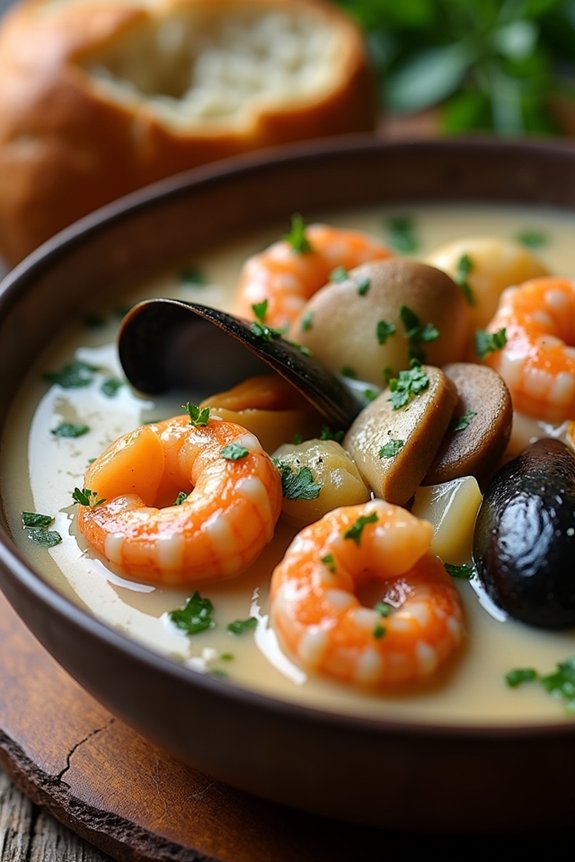
Matelote Normande is a classic French country stew that combines the rich flavors of the Normandy region with fresh seafood. Traditionally, this dish features a variety of fish and shellfish simmered in a luscious sauce made from cider, cream, and often a touch of calvados, an apple brandy native to Normandy.
The addition of mushrooms, onions, and herbs infuses the stew with earthy undertones, making it a hearty and comforting meal perfect for gatherings or a cozy night in. This stew celebrates the bounty of the sea and the orchard, bringing together ingredients that are readily available in Normandy.
The balance of creamy and acidic elements, along with the delicate sweetness of the cider, complements the natural flavors of the seafood beautifully. Matelote Normande is best served with crusty bread or over a bed of rice to soak up the delicious sauce, guaranteeing none of the flavorful broth goes to waste.
Ingredients (for 4-6 people):
- 1 1/2 pounds mixed fish (such as cod, haddock, or monkfish), cut into pieces
- 12 large shrimp, peeled and deveined
- 12 mussels, scrubbed and debearded
- 2 tablespoons olive oil
- 2 tablespoons butter
- 1 large onion, finely chopped
- 2 cloves garlic, minced
- 8 ounces button mushrooms, sliced
- 1 cup dry Normandy cider
- 1/4 cup calvados (optional)
- 1 cup fish stock or chicken broth
- 1 cup heavy cream
- Salt and pepper, to taste
- 2 tablespoons chopped fresh parsley
- 1 teaspoon fresh thyme leaves
- 1 bay leaf
Cooking Instructions:
- Prepare the Seafood: Rinse the fish pieces, shrimp, and mussels under cold water. Pat the fish and shrimp dry with paper towels. Discard any mussels that don’t close when tapped.
- Sauté Vegetables: In a large, heavy-bottomed pot or Dutch oven, heat the olive oil and butter over medium heat. Add the chopped onion and garlic, and sauté until the onion is translucent, about 5 minutes. Stir in the sliced mushrooms and cook for another 3-4 minutes until they start to soften.
- Deglaze with Cider and Calvados: Pour in the cider and calvados (if using), scraping up any browned bits from the bottom of the pot. Allow the liquid to simmer for about 5 minutes to reduce slightly.
- Add Stock and Seasonings: Stir in the fish stock, thyme leaves, and bay leaf. Bring the mixture to a gentle simmer, then reduce the heat to low.
- Cook the Seafood: Gently add the fish and shrimp to the pot, guaranteeing they’re submerged in the broth. Cover the pot and cook for about 5 minutes. Add the mussels, cover again, and cook for an additional 5-7 minutes, or until the mussels have opened and the fish is cooked through.
- Finish with Cream: Remove the bay leaf from the pot. Stir in the heavy cream and season the stew with salt and pepper to taste. Let the stew simmer for another 2-3 minutes to heat the cream through.
- Serve: Ladle the Matelote Normande into bowls, garnishing each serving with fresh parsley. Serve with crusty bread or over rice to enjoy the rich broth.
Extra Tips:
When preparing Matelote Normande, it’s important to use fresh seafood for the best flavor and texture. If fresh seafood is unavailable, frozen fish and shrimp can be substituted, but verify they’re thoroughly thawed before cooking.
Adjust seasoning to your preference, and feel free to vary the types of seafood based on what you have on hand. To enhance the dish further, a squeeze of lemon before serving can add a revitalizing brightness to the stew.

